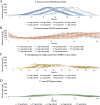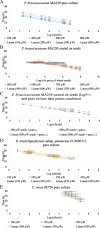Isothermal microcalorimetry for thermal viable count of microorganisms in pure cultures and stabilized formulations
- PMID: 30898089
- PMCID: PMC6429831
- DOI: 10.1186/s12866-019-1432-8
Isothermal microcalorimetry for thermal viable count of microorganisms in pure cultures and stabilized formulations
Abstract
Background: Quantification of viable microorganisms is an important step in microbiological research as well as in microbial product formulation to develop biological control products or probiotics. Often, the efficiency of the resulting product is dependent on the microbial cell density and their viability, which may decrease over time. Commonly, the number of viable cells is determined by serial dilution and plating techniques or flow cytometry. In 2017, we developed a mathematical model for isothermal microcalorimetry (IMC) data analysis and showed that the new method allows for a more rapid quantification of viable fresh and freeze-dried anaerobic Lactobacillus reuteri cells than traditional viable count methods.
Results: This study developed the new method further by applying it to well-known aerophilic plant-beneficial microbial species (Pseudomonas brassicacearum, Bacillus amyloliquefaciens subsp. plantarum and Clonostachys rosea) used in biological control products. We utilized IMC to quantify viable cells in microbial pure cultures as well as when coated onto wheat seeds. The results from this study confirmed that thermal viable count methods are more rapid and sensitive than traditional viable count techniques. Most interestingly, a thermal viable count method was able to quantify microbes coated on seeds despite the presence of the natural microbiota of the seeds. Our results also showed that, in contrast to plating techniques for which clustered cells skew the results, IMC does not require single cells for accurate viable counts.
Conclusions: Thermal viable count methods are novel methods for the rapid quantification of divergent bacterial and fungal species and enhance the speed, sensitivity, and accuracy of routine viable counts of pure cultures and controlled microbiomes such as plant seed coatings.
Keywords: Aerophilic; Biological control; Isothermal microcalorimetry; Microbial products; Plant protection; Plant seed coating; Viable count.
Conflict of interest statement
Ethics approval and consent to participate
Not applicable.
Consent for publication
Not applicable.
Competing interests
The authors declare that they have no competing interests.
Publisher’s Note
Springer Nature remains neutral with regard to jurisdictional claims in published maps and institutional affiliations.
Figures



Similar articles
-
Use of isothermal microcalorimetry to monitor microbial activities.FEMS Microbiol Lett. 2010 Feb;303(1):1-8. doi: 10.1111/j.1574-6968.2009.01819.x. Epub 2009 Oct 12. FEMS Microbiol Lett. 2010. PMID: 19895644 Review.
-
Supercharged MPNs? Automated Determination of High-Throughput Most Probable Number (htMPN) Using Chip-Based 3D Digital PCR.Appl Environ Microbiol. 2022 Aug 9;88(15):e0082222. doi: 10.1128/aem.00822-22. Epub 2022 Jul 20. Appl Environ Microbiol. 2022. PMID: 35856687 Free PMC article.
-
Rapid assessment of viable but non-culturable Bacillus coagulans MTCC 5856 in commercial formulations using Flow cytometry.PLoS One. 2018 Feb 23;13(2):e0192836. doi: 10.1371/journal.pone.0192836. eCollection 2018. PLoS One. 2018. PMID: 29474436 Free PMC article.
-
The determination of viable counts in probiotic cultures microencapsulated by spray-coating.Food Microbiol. 2010 Dec;27(8):1104-11. doi: 10.1016/j.fm.2010.07.017. Epub 2010 Jul 24. Food Microbiol. 2010. PMID: 20832691
-
Recommendations for the viability assessment of probiotics as concentrated cultures and in food matrices.Int J Food Microbiol. 2011 Oct 3;149(3):185-93. doi: 10.1016/j.ijfoodmicro.2011.07.005. Epub 2011 Jul 14. Int J Food Microbiol. 2011. PMID: 21803436 Review.
Cited by
-
Efficacy of a commercial bacteriophage cocktail against planktonic cells and both thin and thick biofilms of skin pathogens, measured using isothermal microcalorimetry.Front Microbiol. 2025 Jul 30;16:1608243. doi: 10.3389/fmicb.2025.1608243. eCollection 2025. Front Microbiol. 2025. PMID: 40809057 Free PMC article.
-
Proof of concept: real-time viability and metabolic profiling of probiotics with isothermal microcalorimetry.Front Microbiol. 2024 Jun 19;15:1391688. doi: 10.3389/fmicb.2024.1391688. eCollection 2024. Front Microbiol. 2024. PMID: 38962141 Free PMC article.
-
Detection and Drug Susceptibility Testing of Neisseria gonorrhoeae Using Isothermal Microcalorimetry.Microorganisms. 2021 Nov 11;9(11):2337. doi: 10.3390/microorganisms9112337. Microorganisms. 2021. PMID: 34835463 Free PMC article.
-
Assessing Viability and Stress Tolerance of Probiotics-A Review.Front Microbiol. 2022 Jan 27;12:818468. doi: 10.3389/fmicb.2021.818468. eCollection 2021. Front Microbiol. 2022. PMID: 35154042 Free PMC article. Review.
References
Publication types
MeSH terms
LinkOut - more resources
Full Text Sources
Molecular Biology Databases

